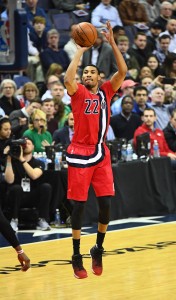Compared to the spending spree summers of 2015 and 2016, this past offseason was a mild showing for players cashing in on major contracts. Yet, quite a few players received deals that appeared above the market rate at the time. Let’s examine how some of the players who signed bloated free agent contracts are performing early on and assess their fantasy value going forward:
Otto Porter Jr., Wizards (four years, $106MM):
Does Simon Helberg warrant $26.5MM per year? In a vacuum, probably not. But in his current environment, the figure is much more understandable. Hollywood’s third-highest-paid TV actor, who stars in The Big Bang Theory, doesn’t carry the mega-successful sitcom, but his efficiency and excellent chemistry with the show’s stars (the industry’s two highest-paid actors) allow him to thrive in his role.
Porter is Washington’s Simon Helberg. The combo forward has evolved since being drafted with the No. 3 overall pick, developing from a high-risk, high-reward 3-and-D prospect to someone who can not only play that role but also is dangerous enough to lead his own sets and take the pressure off of John Wall and Bradley Beal. The Wizards look like legitimate threats to make the Eastern Conference Finals and Porter’s versatility and next-level efficiency (shooting 50% from downtown this season; 57.6% from the field) are major reasons why.
The Nets saw Porter’s talent and potential and wanted to give him his own show in Brooklyn, but the Wizards matched the offer sheet and kept him as a secondary option. Could he succeed as the lead star of the team? Perhaps. Porter, like Helberg (36 years old), is relatively young and could eventually grow into someone capable of carrying a majority share of the load. However, in both cases, the best shot at landing near the top of standings is to remain in their current situations.
Fantasy owners don’t need Porter to take on a bigger role to appreciate his production. His contributions across multiple categories make him a top-20 player in Roto leagues, and while some may be tempted to sell high on Porter given the likelihood that his stats will decline to some extent, it’s best to resist that urge.
The Georgetown product might have the highest fantasy-value-to-star-status ratio in the league, meaning many owners may not appropriately evaluate his worth. Unless you can land a clear upgrade (Paul George, Marc Gasol, Joel Embiid), keep Porter on your squad and enjoy the production.
In ESPN leagues, Porter was selected on average with the No. 44 overall pick. If you nabbed him near that spot, you, like the Wizards, can enjoy an excellent return on your investment.
Tim Hardaway Jr., Knicks (four years, $72MM):
New York’s prized offseason addition has been very busy early on, especially from behind the arc. Only three players (Eric Gordon, James Harden, and Stephen Curry) are taking more three-pointers than Hardaway’s 7.9 per game.
Hardaway is only shooting 30.9% on those attempts. However, while those in Roto leagues may worry about his field goal percentage, the volume – combined with his ability to contribute in other categories – should alleviate those concerns. The 25-year-old is pulling down 4.4 rebounds, dishing out 3.1 assists, and snatching over a steal per game. Value him above players like Will Barton, Dennis Smith Jr., and Lonzo Ball.
Paul Millsap, Nuggets (three years, $90MM):
The Nuggets, though still wildly inconsistent, appear to be a playoff team, something fueled by Millsap’s contributions on the defensive end. However, the power forward has taken a step back on the offensive end and it’s hurt his fantasy stock early on.
Those who drafted Millsap in ESPN leagues took him on average with the No. 36 overall pick and he simply has not produced value from that spot so far this season. His value has fallen more in points leagues than in Roto, though he is still usable in both.
Millsap has never been a master at any one statistical category, but rather a steady force in many. His decline in per-game points (15.7; lowest mark since 2012/13 in Utah), rebounds (4.8; fewest since the 2009/10 season) and assists (2.8; fewest since 2012/13) are discouraging, but he’s just one of nine players averaging at least a block and a steal per contest. He won’t kill you in the percentage categories and he’ll remain his normal self from beyond the arc.
Millsap’s versatile stat line makes him a high-floor player and that will help to mitigate the loss in value from his draft-day price. He could actually be a buy-low target if someone in your league is over-projecting his decline.
Remember, staying active and exploring all opportunities in trades is a key part of fantasy leagues and that means not turning away from players who appear to be on the downswing. If you can properly evaluate, you can get an edge in trade discussions and Millsap’s perceived decline may present you with a chance to win a deal.
Fantasy questions? Take to the comment section below or tweet me at @CW_Crouse.
Statistics are current through Friday morning. Photo courtesy of USA Today Sports Images.
Suddenly teams want rim protectors. THey’re scarce, especially ones that can score. Nerlens Noel will be available December 15. Like the above overpaid guys, he wanted the max and took $5 million while becoming unrestricted this year. What’s he worth? I can see Celtics, Bucks, Warriors, and Cavs wanting him .